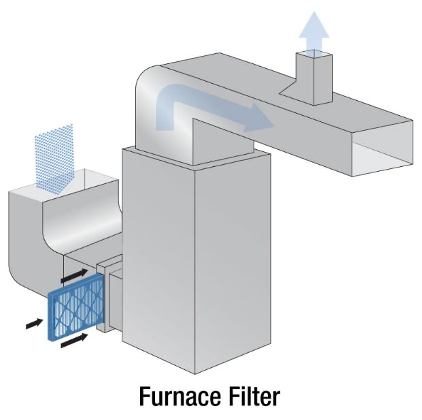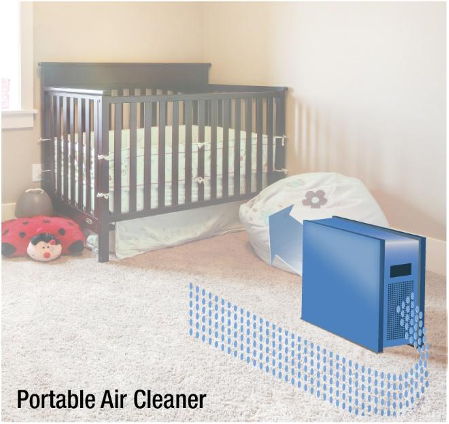Supporting Information
Air Cleaning Supporting Information
Pollutant Removal and Decrease in Indoor Air Pollutant Concentration by Air Cleaners
The extent to which an air cleaner reduces the indoor pollutant concentration depends on the rate of pollutant removal by the air cleaner and on other factors, such as the building’s outdoor air ventilation rate. The performance of some air cleaners may also depend on the rate at which pollutants are generated indoors. For many air cleaners:
Pollutant Removal Rate of Air Cleaner=(Air Flow Rate) x (Fraction of Time Air Cleaner Operates) x (Pollutant Removal Efficiency) x (Indoor Air Pollutant Concentration)
Some air cleaners sold for residential use have a very low air flow rates and, consequently, cannot substantially improve indoor air quality. The pollutant removal efficiency varies from 0 to 1, or 0% to 100%. If the pollutant removal efficiency is 0.5 (or 50%) for a particular pollutant, the concentration of the pollutant in air exiting the air cleaner is 50% of the concentration of the pollutant in the air entering the air cleaner. For many particle air cleaners, the pollutant removal efficiency varies with particle size, and the efficiency is lowest for particles with a diameter of approximately 0.2 micrometers. Some particle filters have MERV ratings to indicate their particle removal efficiency [1]. A higher MERV rating indicates a higher efficiency in removing the small particles most important to health.
To substantially reduce the indoor pollutant concentration, the rate of pollutant removal by the air cleaner must be equal to or larger the rate of pollutant removal by ventilation, assuming clean ventilation air. A typical home has a ventilation airflow rate, due to air leakage, of approximately 0.5 indoor air volumes per hour. In a 1500 square foot (139 square meter) home with 8 feet (2.4 m) ceilings, this ventilation air flow rate equals 100 cubic feet per minute (47 liters per second). Thus, if the air cleaning is applied to the entire house, the air flow rate of the air cleaner multiplied by the fraction of time the air cleaner operates and also multiplied by the pollutant removal efficiency should be 100 cubic feet per minute (47 liters per second) or preferably substantially larger.
The Clean Air Delivery Rate (CADR) http://ahamverifide.org/what-is-the-clean-air-delivery-rate-cadr/ is a parameter used by the Association of Home Appliance Manufacturers (AHAM) to indicate the rates of particle removal by portable air cleaners. AHAM recommends different minimum CADRs depending on the size of the room http://ahamverifide.org/search-for-products/room-air-cleaners/.
Avoiding Air Cleaners That Produce Significant Ozone
California prohibits sale of air cleaners that produce more than a specified amount of ozone. For a list of air cleaners that meet California’s standard go to http://www.arb.ca.gov/research/indoor/aircleaners/certified.htm
For more information, also refer to the U.S. EPA’s web site “Ozone Generators that are Sold as Air Cleaners” at http://www.epa.gov/iaq/pubs/ozonegen.html.
Air Cleaning Technologies
For air cleaning, particle filters and/or media for removing gaseous pollutants may be installed in the ductwork of the heating and cooling system as illustrated in Figure 1. Alternately, one or more standalone air cleaning devices, often called portable air cleaners or air purifiers, may be deployed in commonly used rooms as depicted in Figure 2.
 |
 |
|
Figure 1. Filter installed in forced-air heating system. |
Figure 2. Portable air cleaner installed in a bedroom. |
Tables 1 and 2 below provide an introductory description of the most commonly used air cleaning technologies, with information on their advantages and disadvantages, modes of application, and implications for health summarized briefly. There are a very large number of technologies and variants on technologies. The table is not comprehensive and the entries in the table do not apply to every variant or application of a technology. Many air cleaners employ multiple of the listed technologies. For additional information on the basic designs for gas phase air cleaners, see the U.S EPA’s web site [1] or reference [2].
This web site has focused on air cleaners that use fans to move air through a system that removes pollutants. Limited research has been performed on passive air cleaning in which natural indoor air movement is used together with materials that remove air pollutants. These systems have no fans, thus they are quiet and energy efficient. For example a cloth containing activated carbon that removes ozone can be mounted on a wall, or the normal gypsum wall board can be replaced with a wall board that removes pollutants. No data were identified indicating how these systems affect health or perceived air quality.
Table 1. Technologies commonly used for particle air cleaning.
|
Technology |
Description & principles |
Advantages |
Disadvantages |
Common Applications |
Related Health Data |
|
Fibrous filters |
Particles in air flowing through a porous fibrous media attach to the media and are removed from the air |
Widely available technology Simple, little to go wrong Can have very high particle removal efficiency (depends on system design and particle size)
|
Requires a fan to move air through media. In general, more efficient filters have higher airflow resistance, increasing fan energy Cost of regular changing of filter media every few months to year Standalone units often noisy |
Installed in heating, ventilating and air conditioning systems or in stand-alone portable air cleaners |
Evidence of modest improvement in allergy and asthma health effects Model predictions of substantial health benefits from use of filters to reduce indoor concentrations of particles from outdoor air |
|
Electronic particle air cleaners with fans |
Various designs, most systems electrically charge particles and collect them on electrostatically charged or grounded deposition surfaces |
Widely available technology Lower airflow resistance than fibrous filters, reducing fan energy Can have high particle removal efficiency (depends on system design and particle size) |
Requires a fan to move air through media Can produce ozone as unintentional product. Regular maintenance needed Higher first cost than fibrous filters Decreasing particle removal efficiency during use Standalone units often noisy |
Installed in heating, ventilating and air conditioning systems or in stand-alone portable air cleaners |
Minimal data available The model predictions of health benefits from use of fibrous filters to reduce indoor concentrations of particles from outdoor air are also applicable to effective electronic particle air cleaners |
|
Ion Generators |
High voltages used to ionize air molecules creating ions that attach to and charge particles, charged particles deposit on indoor surfaces |
No fan required, thus, energy efficient and quiet |
Limited data on effectiveness in reducing airborne particles; some devices are clearly ineffective |
Installed in occupied space |
Minimal data available |
|
Ultraviolet germicidal irradiation (UVGI) |
UVGI damages the genetic material of microorganisms destroying their ability to replicate rendering them non-infectious |
Requires no fans, quiet Very low airflow resistance when in heating, ventilating, air conditioning systems Potential high inactivation rates of microorganisms |
Energy cost of ultraviolet lamps Lamp replacement costs Risks of human exposures to ultraviolet light Can produce ozone as unintentional product. Reduced performance at high humidity |
Installed near ceiling of rooms or in heating, ventilating, and air conditioning systems |
Some data available indicating health benefits |
Table 2. Technologies commonly used for gaseous pollutant air cleaning.
|
Technology |
Description & principles |
Advantages |
Disadvantages |
Common Applications |
Related Health Data |
|
Sorbents |
Gaseous pollutants adsorb on porous granular media or condense in pores of media Many types of sorbents with activated carbon most commonly used
|
Widely available technology Can remove broad range of gaseous pollutants with moderate to high efficiency
|
Pollutants can be released from sorbent into indoor air Low effectiveness for low molecular weight pollutants including formaldehyde Must periodically replace sorbent Sorbent lifetime for indoor air applications not well understood Large amount of sorbent needed for long lifetime High sorbent cost Often high airflow resistance increasing fan energy use |
Installed in heating, ventilating and air conditioning systems or in stand-alone portable air cleaners |
Minimal data available
|
|
Chemisorbents |
Gaseous pollutants adsorb on and chemically react with porous granular media |
Widely available technology Can remove broad range of gaseous pollutants with moderate to high efficiency
|
High chemisorbent cost Often high airflow resistance increasing fan energy use |
Installed in heating, ventilating and air conditioning systems or in stand-alone portable air cleaners |
Minimal data available
|
|
Photocatalytic oxidation |
Gaseous pollutants adsorb on a surface coated with a photocatalyst that is irradiated with a light source, usually a source of ultraviolet light; some adsorbed pollutants decompose |
Can remove a range of gaseous pollutants Usually lower airflow resistance than sorbents and chemisorbents, thus, lower fan energy consumption Can destroy some bioaerosols |
Many systems have low pollutant removal efficiency Lamp energy use Cost of periodically replacing lamps Photocatalysts become inactive, with unknown photocatalyst life. Incomplete breakdown of some pollutants can result in formation of new pollutants potentially harmful to health. |
Installed in heating, ventilating and air conditioning systems or in stand-alone portable air cleaners |
Minimal data available |
Table 2. Technologies commonly used for gaseous pollutant air conditioning (continued).
|
Technology |
Description & principles |
Advantages |
Disadvantages |
Common Applications |
Related Health Data |
|
Ozone generators |
Ozone generated and released into indoor air can react with and breakdown some airborne volatile organic compounds |
Quiet and energy efficient |
Releases ozone into indoor air and ozone is a harmful pollutant Generally ineffective in significantly reducing airborne volatile organic compounds unless ozone concentrations are very high Reactions of ozone with airborne volatile organic compounds can lead to production of formaldehyde and ultrafine particles that pose health risks |
Usual application is a standalone portable air cleaner |
No direct measured data on how these devices affect health; however, ozone generators can raise indoor ozone above levels known to be harmful to health |
|
Plasma air cleaners |
Radicals (small reactive molecules) created by electric discharge can oxidize and decompose volatile organic compounds and nitrogen oxides |
Quiet and energy efficient May improve particle removal performance of some particle air cleaners |
Very limited data available on pollutant removal performance in buildings Can produce ozone, see comments on ozone air cleaners Quiet and energy efficient |
Usual application is a standalone portable air cleaner |
No direct measured data on how these devices affect health; however, ozone generating air cleaners can raise indoor ozone above levels known to be harmful to health |
|
Plants |
Plants in buildings can remove some volatile organic compounds |
Quiet and energy efficient |
Not proven to significantly reduce indoor pollutant levels with practical number of plants
Plants and molds on plants and soil can be a source of pollutants |
Plants placed throughout building or in attached greenhouse
One system forces air through plant root zone |
No direct measured health data |
1. ASHRAE, ASHRAE Standard 52.2-2012 Method of testing general ventilation air cleaning devices for removal efficiency by particle size 2012, ASHRAE: Atlanta, GA.
2. Robinson, T.J. and A.E. Quellet, Filters and filtration. ASHRAE Journal, 1999. April 1999: p. 58-63.